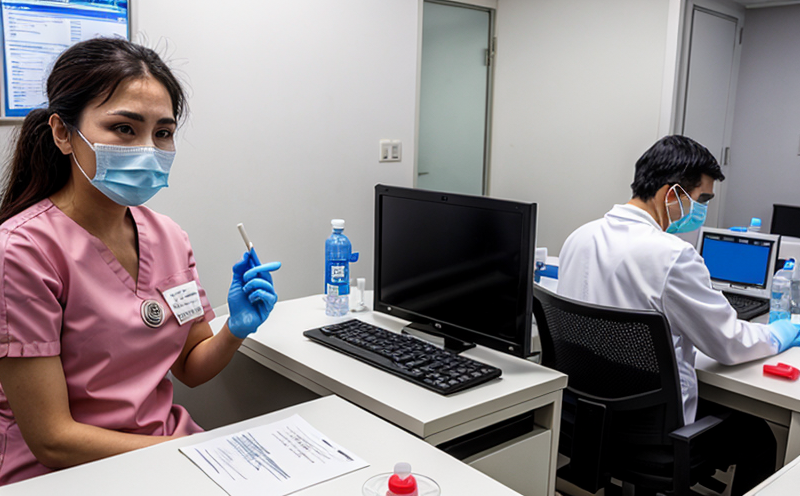Zika Virus Serology Testing in Vector Control Programs
The Zika virus serology testing plays a critical role in vector control programs by providing crucial information on the prevalence and spread of the virus within human populations. This testing is pivotal for understanding the dynamics of infection, identifying high-risk areas, and implementing targeted interventions to reduce transmission.
In regions where Zika virus activity is present or suspected, serology tests can detect both current infections and past exposure to the virus. This information helps public health authorities design effective strategies to control vectors like Aedes aegypti mosquitoes that transmit the virus. By identifying individuals with antibodies against the virus, these tests contribute to surveillance efforts aimed at preventing outbreaks.
The Zika virus serology test typically involves collecting blood samples from individuals suspected of having been exposed to the virus or showing symptoms consistent with Zika infection. These samples are then analyzed using immunoassay techniques such as enzyme-linked immunosorbent assays (ELISAs) and rapid diagnostic tests (RDTs). The results provide quantitative measures of specific antibodies, which can indicate recent or past infections.
Vector control programs rely heavily on this information to prioritize resources and focus efforts in areas where there is a higher likelihood of transmission. This targeted approach ensures that interventions are effective and efficient, minimizing unnecessary actions while maximizing impact. Understanding the spread of the virus through serology testing also aids in evaluating the effectiveness of public health measures over time.
The importance of accurate and timely diagnosis cannot be overstated. Misdiagnosis or delayed identification can lead to missed opportunities for prevention, resulting in increased cases and potential complications such as microcephaly and Guillain-Barré syndrome. Therefore, ensuring that testing methods are reliable and standardized is essential for maintaining public health.
Standardization of these tests ensures consistency across different regions and laboratories, facilitating comparisons between data sets and enhancing the overall reliability of surveillance efforts. This standardization also supports international collaboration in addressing global health challenges posed by infectious diseases like Zika virus.
To achieve this level of accuracy and consistency, various applied standards guide laboratory procedures and interpretation of results. For instance, ISO 15189 specifies requirements for quality and competence in medical laboratories, ensuring that testing facilities meet stringent criteria regarding proficiency, calibration, and validation.
| Applied Standards | Description |
|---|---|
| ISO 15189: Medical Laboratories | Ensures quality and competence in medical laboratories through stringent criteria for proficiency, calibration, validation. |
| ASTM E2607-13: Standard Practice for Determining Zika Virus Neutralizing Antibody Titers by Microneutralization Assay | Provides a standardized method for determining neutralizing antibody titers against the Zika virus using microneutralization assays. |
The use of these standards helps maintain high-quality testing practices, which is vital given the potential public health implications associated with incorrect test results. By adhering to such guidelines, laboratories can ensure that their findings contribute accurately and reliably to broader epidemiological studies and public health decisions.
Applied Standards
| Standard | Description |
|---|---|
| ISO 15189: Medical Laboratories | Ensures quality and competence in medical laboratories through stringent criteria for proficiency, calibration, validation. |
| ASTM E2607-13: Standard Practice for Determining Zika Virus Neutralizing Antibody Titers by Microneutralization Assay | Provides a standardized method for determining neutralizing antibody titers against the Zika virus using microneutralization assays. |
Industry Applications
Zika virus serology testing finds application in several key areas within vector control programs:
- Epidemiological Surveillance: Monitoring the prevalence and geographic spread of Zika virus infections.
- Vaccination Campaigns: Evaluating vaccine efficacy by tracking antibody responses post-vaccination.
- Vector Control Strategies: Guiding resource allocation to regions most affected by Zika virus transmission.
- Pregnancy Screening: Identifying pregnant women who may benefit from additional protection measures against the virus.
These applications underscore the importance of accurate and timely serology testing in supporting effective vector control initiatives. The data generated through these tests informs strategic planning and helps reduce the burden on healthcare systems by preventing severe outcomes associated with Zika infection.
International Acceptance and Recognition
Zika virus serology testing is widely accepted and recognized globally due to its critical role in controlling vector-borne diseases. Many countries have implemented national guidelines based on international standards, ensuring consistent practices across borders.
- WHO Recommendations: The World Health Organization (WHO) recommends Zika virus serology as part of comprehensive surveillance systems for tracking the disease.
- EPA Guidelines: Insecticide registration processes often require evidence supporting efficacy claims, which can be provided by reliable serology data.
| International Acceptance and Recognition | Description |
|---|---|
| WHO Recommendations | The World Health Organization (WHO) recommends Zika virus serology as part of comprehensive surveillance systems for tracking the disease. |
| EPA Guidelines | Insecticide registration processes often require evidence supporting efficacy claims, which can be provided by reliable serology data. |
The widespread adoption of these tests demonstrates their value in contributing to global health security. As more regions face the threat of vector-borne diseases like Zika virus, the importance of robust diagnostic tools cannot be overstated. By leveraging internationally accepted methods and guidelines, laboratories can play a vital role in protecting public health.





